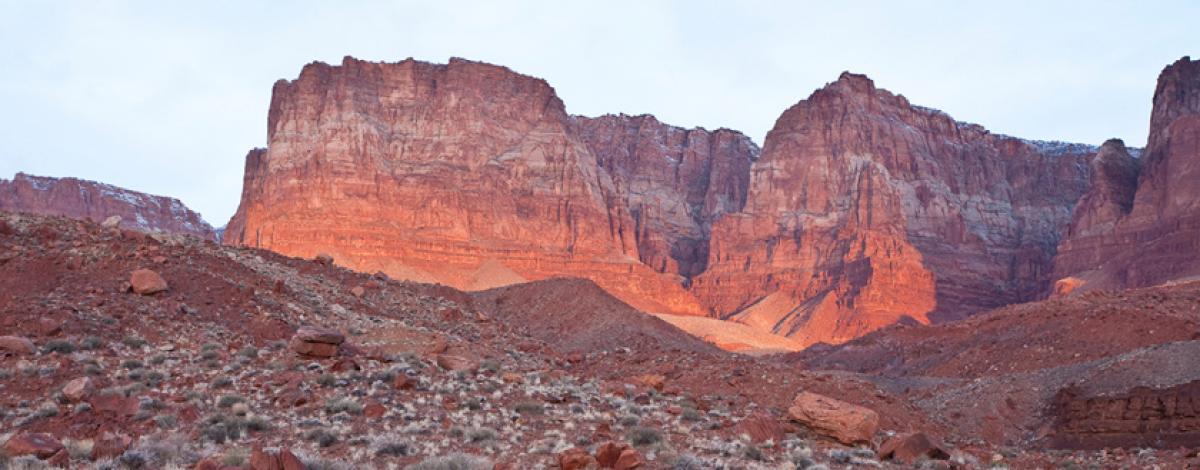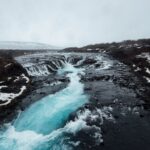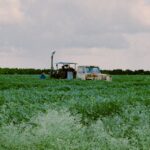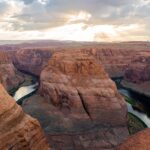Image source: blm.gov
Immerse yourself in the raw beauty of Vermilion Cliffs National Monument with our glamping guide. Explore the stark wilderness, vibrant rock formations, and thrilling weather patterns in this geologist’s heaven. Pack your adventurous spirit!
Address: Marble Canyon, AZ 86036, USA
Google Maps Page: https://maps.google.com/?cid=2057170510297856465
Website: https://www.blm.gov/national-conservation-lands/arizona/vermilion-cliffs
Accommodation Options
Embark on an incredible journey, unraveling the raw beauty of the Vermilion Cliffs National Monument, a geologic gem nestled in north Arizona. Blanketed in untamed wilderness, this vast 280,000-acre monument dresses your exploration in breathtaking landscapes – from the multicolored rock cliffs standing majestically against the skyline to the bewitching confluence of the muddy Paris river and the crystal-clear Colorado river at Lees Ferry.
Brace yourself for a remarkable assortment of landscapes as you traverse the Paria Plateau, Vermilion Cliffs, Coyote Buttes, and Paria Canyon. In one moment you’ll be deep amidst the swirling patterns of Cottonwood cove with numerous 4×4 trails opening up chances for unscripted adventures, and in the next, you’re sure to be swept away by the marvels of the white pocket rock formations.
The glamping accommodation promises to lend an unforgettable edge to your journey. Tucked in the heart of this seclusion, our glamping setups bring comfort to the wilderness. You are offered a chance to rest and rejuvenate under canvas, to wake up in the company of the breathtaking cliffs and sleep under a star-studded sky, becoming an intimate part of the landscape that stands as a testament to the history of people and our planet.
While the Vermilion Cliffs requires certain wilderness areas to have a permit, a significant part stands unshackled, extending an open invite to the wandering souls. For those looking to expand their horizons and veer off the beaten path, numerous turn-offs and bonus roads offer sightings that are nothing short of a spectacle.
Overall, glamping in the enigmatic Vermilion Cliffs National Monument is an experience that hurls you into an astounding landscape that’s hard to believe resides on the same planet as the rest of humanity. A visit here shouldn’t just be on your itinerary, it should be a fixture on your bucket list.
The Glamping Experience at Vermilion Cliffs National Monument
As your adventurous spirit thrives, glamping at Vermilion Cliffs National Monument becomes a sensory celebration of solitude, boundless skies and raw, staggering beauty. Consider this a gentle immersion into the weaving trails etching the grandeur of the vermillion plateau. Here, beneath a dome of never-ending blue, the soft whisper of the wind mingles with the crunch of your footfalls on the gritty sand.
Your journey skates along the rims of vermilion cliffs, close enough to get tantalizing peeks, but just beyond your reach, the cliffs shyly conceal themselves. You find yourself intertwined in an intricate dance of exploration and mystery, following the trails that flirt with the looming cliffs but never quite touch them.
The terrain stretches vast and seemingly endless, like an artist’s easel speckled with an explosion of colors. It’s a concert of contrasts where the mundane stretches of trails burst into life at Cottonwood Cove and White Pocket rock formations. Here, life begins to mimic art, as the cliffs yield into the poetic swirls of multicolored rock formations that seem lifted from a surrealistic painting.
At each turn, you’re embraced by the raw beauty of the area, noticeably devoid of urban fingerprints. The wilderness is pure and untouched, disturbed only by your steps on the sandy trails and the low hum of your 4×4 journeying through the rough gravel roads. The unexpected fusion of the muddy Paris River with the clear Colorado River at Lees Ferry narrates nature’s own stories in whispers you can almost hear. It’s as if you’re stepping into another world, one beyond the bounds of everyday human existence.
The sense of awe provoked by this enchanting landscape is soon accompanied by an adrenaline rush when the heaven’s break open. Skipping a canyon hike due to spontaneous thunderstorms and possible flash flooding adds an unforeseen spark to your adventure. But as the rain pelts down, casting a shimmering sheen on your surroundings, you’re reminded that there’s also a thrilling beauty to its tantrums.
Glamping here is not just a temporary retreat but a deep-dive into an archaeologist’s dream, a geologist’s heaven, exploring the history of our planet etched in the infinite lines of the cliffs. The entire experience becomes a bucket list masterpiece, where you’re left pinching yourself to ensure you’re still on Earth and not drifting through an otherworldly dreamscape.
Activities at Vermilion Cliffs National Monument
Engage yourself in the ethereal vibes of Vermilion Cliffs National Monument as you undertake thrilling outdoor activities. Start with the abundant 4×4 trails that weave through the vermillion plateau, making your way towards Cottonwood Cove and White Pocket rock formations. Revel in the imposing views of the multicolored rock cliffs and the magical confluence of muddy waters from the Paria River and the pristine Colorado River at Lees Ferry, a sight to behold!
But, remember, an off-road adventure isn’t for everyone, especially the inexperienced. Travel the first three miles to adapt before proceeding. For the experienced 4×4 enthusiasts, this is your playground – enjoy it, ride it end to end, discovering the hidden turn-offs and bonus roads.
Remember, the trails won’t always lead straight to the cliffs’ edge. Instead, they pave the way for short hikes, usually ending 12 miles from the cliffs. These hikes are a fantastic opportunity to get closer to the rugged beauty of Vermilion Cliffs. However, be cautious of weather conditions as sudden rain or snow can make the trails impassable.
Sadly, entering the wilderness areas needs a permit, but the rest of the monument is wide open. Enjoy the opportunity to feel like you’re far from the rest of humanity, in a landscape so astonishing and foreign, your words and photos will never do it justice.
The Vermillion Cliffs are indeed a bucket list item for anyone interested in the history and beauty of our planet. Spend an entire day witnessing the raw beauty of the cliffs and exploring the endless trails that offer a myriad of breathtaking sights. Just remember to respect the environment and take the necessary precautions! So hit the road and let the adventure begin!
What is the area around Vermilion Cliffs National Monument like (Marble Canyon)?
Marble Canyon, Arizona is a captivating geographical location that rests at an elevation of approximately 3,500 feet. Covering a vast area of land, the landscape of Marble Canyon is nothing short of enthralling, filled with an array of natural wonders that complement the largely desert terrain.
The terrain is primarily semi-arid with dramatic sceneries that are colored with a fusion of painted desert and rugged, rocky outcrops. You can notice the steep, sheer cliffs and undulating layers of rocks that have been sculpted over time by the forces of nature. The area is home to a variety of flora and fauna that have adapted to desert life.
Marble Canyon marks the western boundary of the Navajo Nation and the eastern end of the Grand Canyon. It got its name from its walls that have weathered to a slick, glassy marble-like surface. The layered appearance of the different types of rock that make up the canyon walls provides a visually stunning color variance that is brilliant in sunlight.
One of the major natural attractions at Marble Canyon is the Colorado River, a hotspot for white-water rafting. Navajo Bridge is another iconic spot. This bridge connects the north rim and the south rim of the Grand Canyon, and from its peak, you can enjoy splendid views of the Colorado River.
Lees Ferry, strategically placed in the canyon, has historical significance and is the only place within Glen Canyon where drivers can access the Colorado River. It’s now a common launch area for river runners starting their journey through the Grand Canyon.
The Vermilion Cliffs National Monument is also a popular attraction near Marble Canyon. It’s home to spectacular colorful sandstone formations and a diverse range of wildlife. It is also famous for “The Wave”, a sandstone rock formation famous among hikers and photographers for its colorful, undulating forms, and the rugged, trackless hike required to reach it.
Additionally, Cliff Dwellers, located nearby, is a crumbled pueblo from the age-old Native American tribes and a place worth visiting for its historical importance.
For nature lovers, adventure enthusiasts, or just explorers, the Marble Canyon region in Arizona offers an awe-inspiring journey filled with anecdotes of natural splendor and human history.
What Wildlife might you see at Vermilion Cliffs National Monument?
At Marble Canyon, Arizona, you can witness a diverse array of wildlife. Some of the long list includes,
Mammals: Mule Deer, Cottontail Rabbits, Jackrabbits, Coyotes, Porcupines, and occasionally Mountain Lions and Bobcats.
Reptiles: You can spot animals like the Desert Tortoise, Gila Monster, and various species of rattlesnakes, lizards, and geckos.
Birds: There is an abundance of bird species like the California Condor, Peregrine Falcon, Red-tailed Hawk, American Kestrel, and several species of songbirds, waterfowl, owls, and vultures.
Insects: A wide variety of butterflies and beetles are usually sighted too.
Aquatic: The Colorado River that runs through the Marble Canyon houses various fish species including Rainbow Trout and Brown Trout.
The diversity depends on the time of year and weather conditions, of course!
When is the best time to visit Vermilion Cliffs National Monument?
Marble Canyon, situated in northern Arizona, showcases each season distinctly due to its high desert setting, surrounded by the striking landscapes and canyons, and is best known to host the starting point of Grand Canyon river trips.
In Spring (March through May) the weather is quite pleasant and temperate. Highs reach between 60-80 degrees Fahrenheit, while the lows can still drop to around 30-50 degrees. Spring sees a mix of sunny days and occasional rain showers, causing the desert spring flowers to blossom and paint the landscape with vibrant colors.
Summers (June through August) are typically hot and mostly dry, with temperatures reaching anywhere from 85-100 degrees Fahrenheit during the day. The evenings are cooler and more comfortable with temperatures dropping to between 60-70 degrees. The heat can make outdoor activities strenuous, especially at midday.
The Fall (September through November) brings cooler weather savoring the landscape with autumn colors. Daytime temperatures range from 60-80 degrees Fahrenheit and nighttime temperatures can drop to 40-60 degrees. This season is a lovely time to visit as the trees cast fiery colors against the canyon backdrop.
Winter (December through February) can be cold but doesn’t get as harsh as many places. Daytime highs can range from 40-60 degrees Fahrenheit with low temperatures dropping to around 20-40 degrees. It’s a relatively dry winter, but occasional snowfall can add a striking contrast to the deep reds of the canyon.
The best time to visit Marble Canyon would generally be in the spring or fall, depending on your preferences. Spring brings the desert to life with wildflowers, and the cooler temperatures make hiking and exploring much more comfortable. Fall offers fantastic weather and scenery with the changing colors of trees. These two seasons provide the best climate and visuals for outdoor activities such as hiking, fishing, and rafting the Colorado River.
Before you travel!
While we strive to provide accurate and comprehensive details about various glamping locations across the USA, it’s important to note that we haven’t personally visited each and every site mentioned in this website. As such, there might be occasional discrepancies or outdated information in our descriptions. Before finalizing any travel plans or making decisions based on our content, we strongly recommend reaching out to the specific glamping location to verify any details or gather additional information. Your adventure deserves thorough planning, and a quick check can ensure you have the most up-to-date and accurate details!




